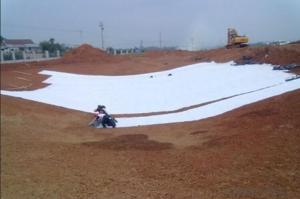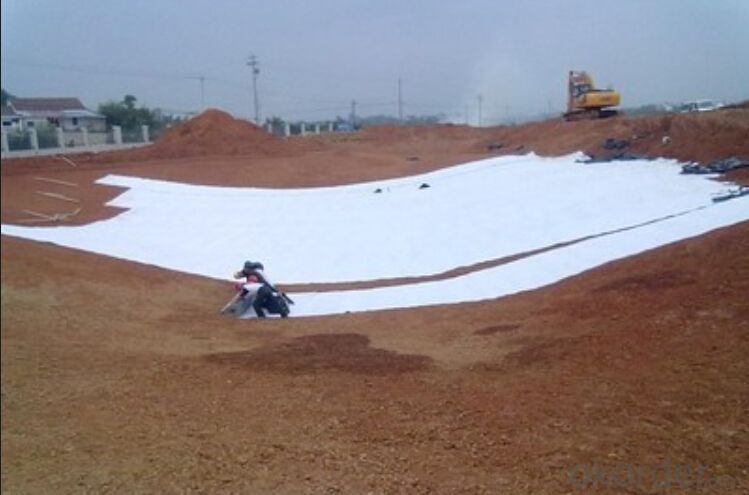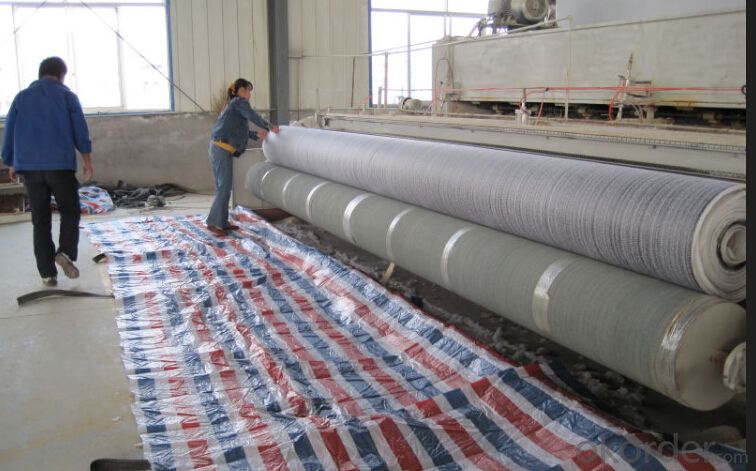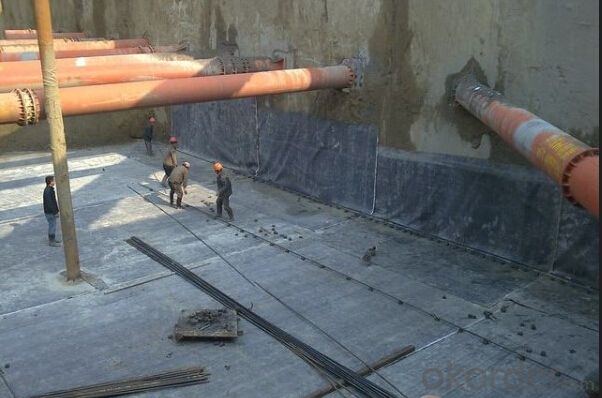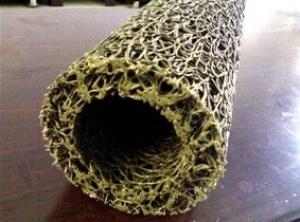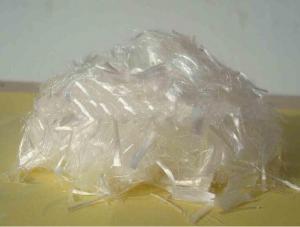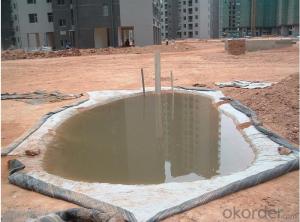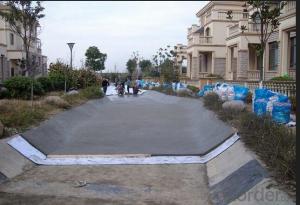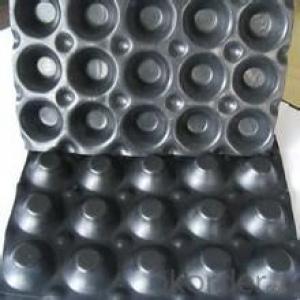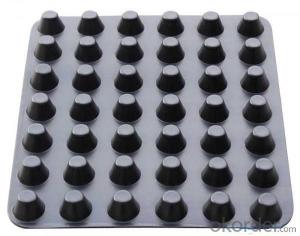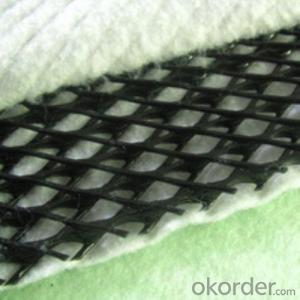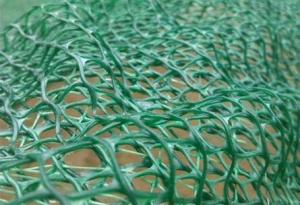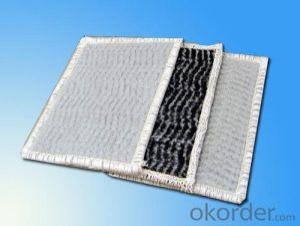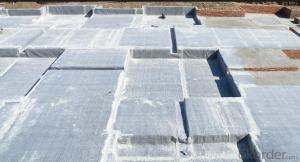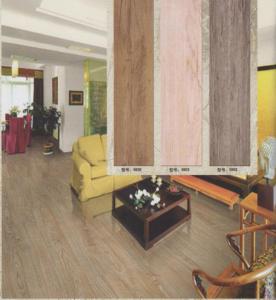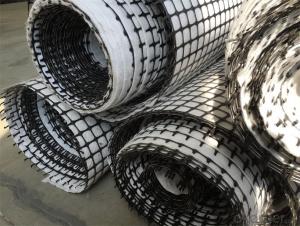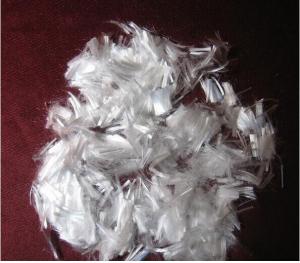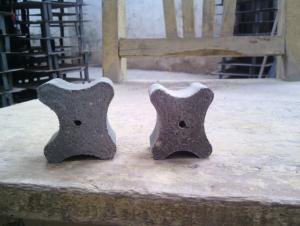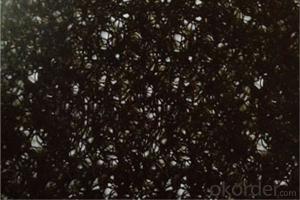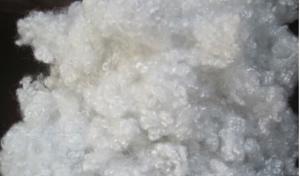Hot Sell Geocomposite Geosynthetic Clay Liner/GCL
- Loading Port:
- Qingdao
- Payment Terms:
- TT OR LC
- Min Order Qty:
- 5000 m²
- Supply Capability:
- 100000 m²/month
OKorder Service Pledge
OKorder Financial Service
You Might Also Like
GCL(Geocomposite Geosynthetic Clay Liner)
Description :
Geosynthetic clay liners (GCLs) are high performance needle punched environmental reinforced composites which combine two durable geotextile outer layers with a uniform core of natural sodium bentonite clay to form a hydraulic barrier. Fibers from the non-woven geotextile are needle punched through the layer of bentonite and incorporated into the other geotextile (either a woven or non-woven).when hydrated under a confining load, the bentonite swells to form a low permeability clay layer with the equivalent hydraulic protection of several feet of compacted clay.
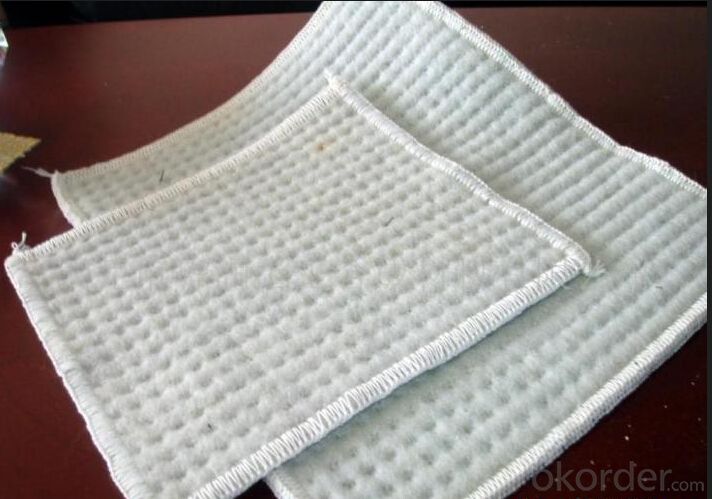
Specification:
Mass per unit ≥ 4000g / m²
Width: 4-6 m
Size: 5.8 x 30m , or customized
bentonite sandwiched between two layers of geotextile
Features:
1) Environment friendly. Liu Fangzi GCL is made of natural raw materials of sodium bentonite. Aging and corrosion never happen. It can keep its quality and then it does not cause any injuries and pollution for human and the environment. It is not only waterproof, but also has good ventilation performance. It can stick up for the exchange of the ecological environment. It is a pure natural, new, green waterproof material.
2) Permanent waterproof, excellent performance. Natural sodium bentonite has been formed for billions of years.Its waterproof properties are much longer than that of the buildings. Sodium bentonite would transform to high density septum under hydro pressure. When the thickness is 3mm, the permeability is below a×10-11/sec(a=1~9), which equals to the density of 100 times of the clay with 30 mm thickness. Water retention performance is evident.
3) Easy to use. Bentonite powder, nails and washers are enough for connection and fixation. Construction is not constrained by weather conditions and it could be taken under cold or wet conditions. Bentonite powder is spread on overlap point. When water comes, GCL would be overlapped automatically. It has been so far the only material that starts the waterproof effect by water in the world. It is not necessary to take additional examination when the construction is completed. The repair works are easy in case of waterproof defects. Among the existing waterproof materials, GCL’s construction period is the shortest and its operation is the easiest. It has an eminent effect on shortening the construction period as well as saving the cost.
4) Strong Self-Restore Capacity. The integration between waterproof material and its target enables GCL a 20~28 times swelling volume. Even if concrete structure trembles or subsides, the bentonite in GCL would restore the crack of 2mm or below on the concrete structure immediately. Even if the diameter of perforation reaches 30 mm, the restoration will be finished within 15 days completely.
Applications:
Seepage proofing, anticorrosion, leaking stoppage and reinforcement
1. Municipal engineering, underground construction of subway, buildings as well as the roof tank.
2. Environmental sanitation, solid waste landfill, sewage farm, industrial waste
3. water conservancy, lake, river, dam and reservoir.
4. Garden and park, artificial lake and golf cause pool.
5. Petrochemical engineering, mining industry and agriculture engineering
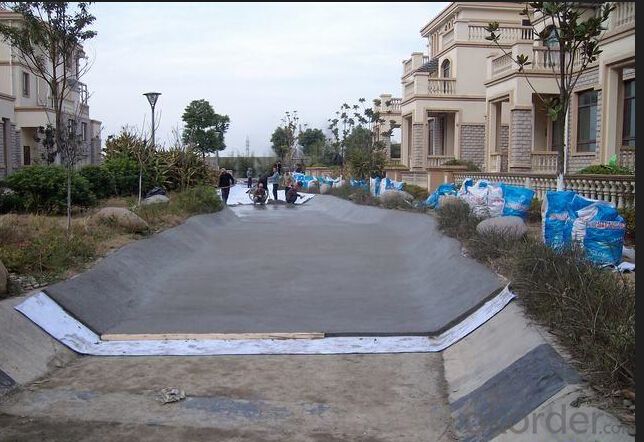
GCL Technical Index
Item | Specification | ||||
GCL-NP | GCL-OF | GCL-AH | |||
Mass per unit g/m2 | ≥ 4000 (not less than the specified value) | ≥ 4000 (not less than the specified value) | ≥ 4000 (not less than the specified value) | ||
GCL expansion index ml/2g | ≥24 | ≥24 | ≥24 | ||
Blue absorption power g/100g | ≥ 30 | ≥ 30 | ≥ 30 | ||
Tensile Strength N/ 100mm | ≥ 600 | ≥ 700 | ≥ 600 | ||
Elongation at maximum load % | ≥ 10 | ≥ 10 | ≥ 8 | ||
Peel strength N / 100mm | Nonwoven geotextile and woven geotextile | ≥ 40 | ≥ 40 | - | |
PE geommebrane and nonwoven geotextile | - | ≥ 30 | - | ||
Permeability coefficient m/s | ≤ 5.0x10-11 | ≤ 5.0x10-12 | ≤ 1.0x10-12 | ||
Hydrostatic pressure resistant | 0.4 Mpa , 1h, no leakage | 0.6 Mpa ,1h,no leakage | 0.6Mpa ,1h, no leakage | ||
Filter loss ml | ≤ 18 | ≤ 18 | ≤ 18 | ||
Durability of bentonite ml/ 2g | ≥ 20 | ≥ 20 | |||
FAQ:
How many quantity for one 20'' container?
About 5,000m2, 16rolls
What's your delivery time?
About 15-20days against deposit received
. What's your package?
Per roll with two pieces woven bag
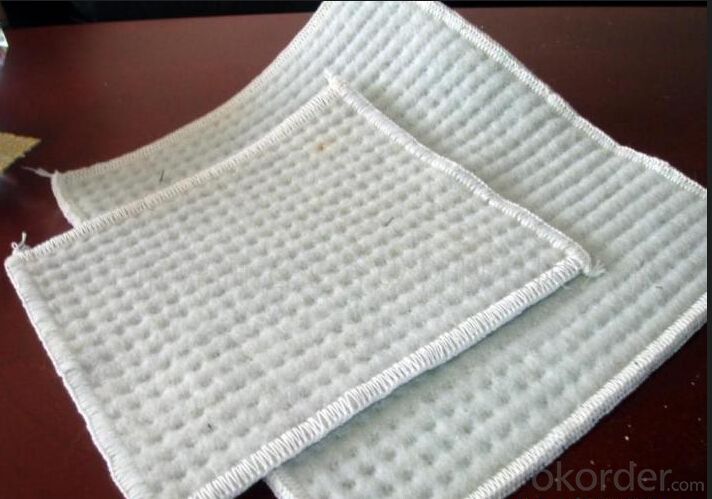
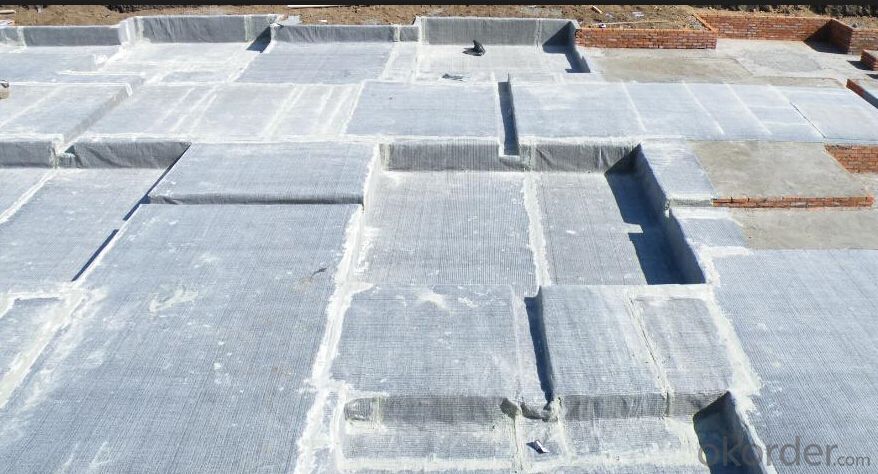
- Q: What are the different types of geosynthetics used in earthwork applications?
- The different types of geosynthetics used in earthwork applications include geotextiles, geogrids, geocomposites, geomembranes, geonets, and geosynthetic clay liners.
- Q: Can concrete pipes be used for drainage systems?
- Yes, concrete pipes are commonly used for drainage systems due to their durability, strength, and resistance to corrosion. They effectively convey water and are suitable for various applications, including stormwater management and wastewater systems.
- Q: What are the advantages of using geotextile tubes in beach nourishment projects?
- Geotextile tubes offer several advantages in beach nourishment projects. Firstly, they provide an effective and cost-efficient solution for erosion control and shoreline protection. Secondly, these tubes are highly durable and resistant to harsh weather conditions, ensuring long-term stability of the beach. Additionally, geotextile tubes are environmentally friendly as they are made from recyclable materials and do not harm marine life. Lastly, the use of these tubes allows for a quick and efficient installation process, minimizing disruption to the beach and reducing project timelines.
- Q: How do earthwork products contribute to wildlife habitat creation?
- Earthwork products such as berms, ponds, and wetlands play a crucial role in creating and enhancing wildlife habitats. These structures provide diverse and suitable environments for various species to thrive. Berms, for example, can act as protective barriers and create microclimates that support the growth of vegetation preferred by certain wildlife. Ponds and wetlands offer water sources and breeding grounds for amphibians, birds, and other aquatic species. By altering the landscape and incorporating earthwork products, we can create habitats that attract and sustain a wide range of wildlife, ultimately promoting biodiversity and ecological balance.
- Q: Can earthwork products be used in landscaping projects?
- Yes, earthwork products can be used in landscaping projects. Earthwork products such as soil, gravel, sand, and stone can be utilized for various landscaping purposes such as creating pathways, building retaining walls, constructing raised beds, and enhancing the overall aesthetics of the outdoor space.
- Q: How do earthwork products contribute to erosion control?
- Earthwork products, such as geotextiles, gabions, and retaining walls, play a crucial role in erosion control. Geotextiles act as a protective barrier, preventing soil erosion by stabilizing the ground and reducing water flow velocity. Gabions, on the other hand, are wire mesh containers filled with rocks, which are used to control erosion by providing a stable and permeable structure that absorbs the energy of flowing water, thus minimizing soil displacement. Retaining walls also help in erosion control by holding back soil and preventing it from being washed away by rainwater or surface runoff. In summary, earthwork products serve as effective measures to control erosion by providing stability, reducing water flow, and protecting soil from displacement.
- Q: How are geosynthetic clay liners installed in landfill projects?
- Geosynthetic clay liners (GCLs) are typically installed in landfill projects by following a specific process. First, the landfill subgrade is prepared by removing any loose or unstable materials and ensuring proper compaction. Next, a geotextile fabric is placed on the subgrade to protect the GCL from damage. The GCL rolls are then carefully unrolled and overlapped, with the edges and ends properly sealed using a bentonite-based adhesive or sodium bentonite powder. The GCL is then covered with another layer of geotextile fabric to protect it during subsequent construction activities. Overall, the installation of GCLs in landfill projects requires precise handling and attention to detail to ensure their effectiveness in preventing contaminant leakage.
- Q: What are the advantages of using geosynthetic materials in canal lining projects?
- There are several advantages to using geosynthetic materials in canal lining projects. Firstly, geosynthetics provide excellent resistance to erosion and chemical degradation, ensuring long-term durability of the canal lining. Secondly, these materials offer superior hydraulic performance, allowing for efficient water flow and reduced seepage. Additionally, geosynthetics are lightweight and easy to install, saving time and labor costs during construction. Lastly, these materials are highly flexible and adaptable, making them suitable for various project conditions and allowing for effective reinforcement and stabilization of the canal lining.
- Q: How can geopipes be used in underground water supply systems?
- Geopipes can be used in underground water supply systems to efficiently transport water from source to destination. These pipes are designed with high-density polyethylene material, which makes them resistant to corrosion, chemicals, and physical damage. This durability ensures a long lifespan for the pipes, reducing the need for frequent replacements. Additionally, the smooth inner surface of geopipes minimizes friction and allows for a continuous flow of water, preventing clogs and blockages. The flexibility of these pipes enables easy installation around obstacles and contours, facilitating a more cost-effective and efficient water distribution network. Overall, geopipes contribute to the reliability and sustainability of underground water supply systems.
- Q: How do earthwork products contribute to soil stabilization in mining areas?
- Earthwork products such as geotextiles, geogrids, and geomembranes play a crucial role in soil stabilization in mining areas. These products are designed to reinforce and stabilize the soil, preventing erosion and slope failures. They act as a barrier between the soil and the external forces, distributing the load evenly and reducing the risk of soil movement. Additionally, earthwork products can control water flow, drainage, and filtration in mining areas, further enhancing soil stability and preventing environmental degradation.
Send your message to us
Hot Sell Geocomposite Geosynthetic Clay Liner/GCL
- Loading Port:
- Qingdao
- Payment Terms:
- TT OR LC
- Min Order Qty:
- 5000 m²
- Supply Capability:
- 100000 m²/month
OKorder Service Pledge
OKorder Financial Service
Similar products
Hot products
Hot Searches
Related keywords
